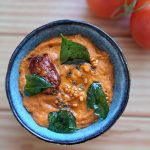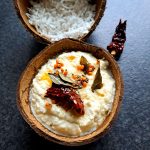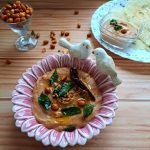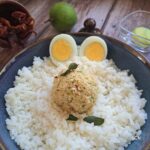Raw mango/Pacha manga chammanthi

Raw mango/Pacha manga chammanthi is a flavourful and tangy chutney that holds a special place in Kerala cuisine. The term “chammanthi” refers to a type of chutney or dip commonly found in South Indian cuisine, particularly in Kerala. Chammanthi can vary in flavour and texture, often spicy, tangy, or sweet, depending on the ingredients used.
Made with the sourness of raw mango, the richness of freshly grated coconut, and the heat from chillies, this chutney is a perfect accompaniment to rice, dosa, or even kanji. Its vibrant taste comes together quickly with just a few ingredients, making it a go-to side dish when you crave something zesty and refreshing. Whether you’re looking to add a traditional touch to your meals or simply love the burst of tropical flavours, raw mango chammanthi is a must-try recipe!
Ammikallu
Traditionally, pacha manga chammanthi is prepared using an ammikallu. The ammikallu is a traditional stone grinder that has been an essential part of South Indian kitchens for centuries. Made from a flat stone base with a smaller stone roller (known as kuzhavi), the ammikallu is used for grinding spices, herbs, and wet ingredients to a coarse texture. It plays a crucial role in preparing authentic chutneys, spice pastes, and masalas which are key to many Indian dishes.
The process of grinding on the ammikallu is manual and slow, allowing the ingredients to release their natural oils and flavours gradually, which results in a richer taste. The stone’s rough surface helps in grinding ingredients to the perfect texture without overheating, preserving the freshness and aroma of the spices and herbs.
While modern appliances like mixers and blenders have largely replaced it in many households, the ammikallu remains cherished for the authentic flavour it brings to traditional recipes. This method offers a texture and taste for dishes like chammanthi or masala pastes that machines cannot easily replicate. This time-honoured method creates a coarse yet balanced chutney that pairs beautifully with rice, kanji, dosa, or idli.
Balance the sourness:
Raw mango can vary in sourness. Start with a small amount and adjust according to your taste. If the mango is too sour, balance it with a bit more coconut or a tiny pinch of jaggery.
Coarse texture:
Chammanthi is traditionally coarse, not too smooth. Avoid over-grinding to retain the authentic texture. Use minimal water, or grind without water for a thick, dense chutney.
Tamarind adjustment:
If the raw mango isn’t sour enough, a small piece of tamarind can enhance the tangy flavour without overpowering the dish.
Enhance the flavour with oil:
Drizzling a little coconut oil over the chammanthi before serving not only adds richness but also intensifies the traditional flavour.
Spice control:
Adjust the chillies based on your heat tolerance. You can mix red chillies for heat and green chillies for a fresh spice flavour.
Shallots for sweetness:
Adding a few shallots or small onions brings a natural sweetness that balances the tangy and spicy notes.
Resting time:
Let the chammanthi rest for 10-15 minutes after grinding. This allows the flavours to meld and intensify.
Serving suggestion:
Serve the chammanthi with kanji (rice porridge) or plain rice for a comforting, traditional Kerala meal. It also pairs well with dosa, idli, or even chapati.





Raw mango chammanthi
Ingredients
- ½ raw mango chopped (adjust based on the sourness you prefer)
- ½ -3/4 cup grated coconut
- 1-2 dried red chillies adjust to your spice preference
- 1-2 shallots small onions
- 1-2 green chillies optional, for extra heat
- ½ inch piece of ginger
- A small bunch of curry leaves
- Salt to taste
- A small piece of tamarind optional, if mango isn’t too sour
- 1 tsp coconut oil optional, for garnishing
Instructions
- Add the raw mango, dried red chillies, shallots, ginger, green chillies (if using), curry leaves, and salt to a blender. Grind everything to a coarse paste without adding water. The chutney should be thick and not too smooth.
- Now add the grated coconut and grind again to a coarse paste. Check the seasoning and adjust salt or spiciness as needed. If the mango isn’t sour enough, you can add a small piece of tamarind while grinding.
- Transfer the chammanthi to a serving bowl. Drizzle a little coconut oil over it if you like. This enhances the flavour and gives it a traditional touch.
- Enjoy this raw mango chammanthi with rice, dosa, or idli for a tangy and spicy kick!
Notes
Frequently Asked Questions
If the mango is too sour, balance it by adding more coconut or a tiny pinch of jaggery. You can also reduce the quantity of mango used in the recipe.
Raw mango chammanthi is best enjoyed fresh, but it can be stored in an airtight container in the refrigerator for up to 2 days. The flavours may intensify over time.
Chammanthi is traditionally made with raw mango for its tanginess. Using ripe mango will give a sweet flavour and won’t offer the same tangy profile.
If the chammanthi turns out too spicy, you can add more coconut to tone down the heat. Adding a bit of jaggery can also help balance the spiciness.
Raw mango chammanthi pairs well with rice, kanji (rice porridge), dosa, idli, chapati, or even as a dip for snacks like vada.
If your chammanthi turns out too watery, add more grated coconut to thicken it. Avoid adding water while grinding, as chammanthi is meant to be thick and coarse.
Tamarind is optional and only needed if the mango is not tangy enough. Raw mango itself provides enough sourness in most cases.

1 thought on “Raw mango/Pacha manga chammanthi”